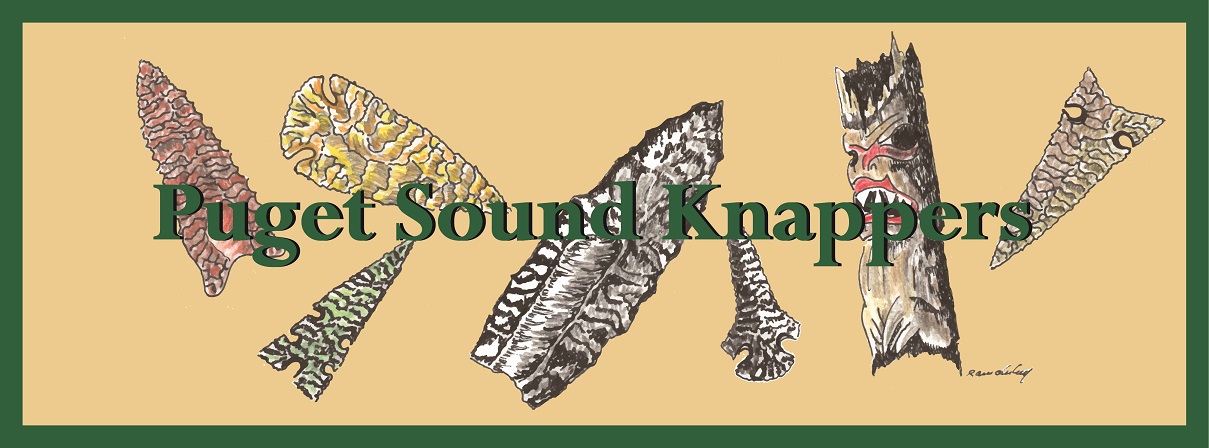|
Flintknapping and Stone Tools Found in Oregon
By Dennis Torresdal with contributions from Robin Harrower and MarkFitzsimon
(By Permission of the Oregon Archaeological Society)
Special thanks to David Kaiser, President - Oregon Archaeological Society
Introduction - Flintknapping is the modern name for the process of making flaked stone tools. Besides arrow points and atlatl points, now commonly referred to as projectile points, other stone, pointed or edged tools such as spears, knives, scrapers, drills, gravers and burins (engraving tools) and cutting and chopping tools were also formed through flintknapping. The variation in the shapes and sizes of these tools, as found in archaeological excavations, reflects the types of stone available, animals hunted, food gathered, and how these materials were processed. Some of the flaked tools were so elaborate, or highly decorated, that their importance is speculated to have been for trade or ceremony.
The purpose of this document is to introduce the reader to flintknapping and examples of stone tools found in Oregon and Washington. The technique of flintknapping is briefly described in order to explain how these tools were made. A discussion follows on the time periods in which various stone tools occurred and how these tools changed over time.
This educational publication is not intended to teach flintknapping, although a brief discussion on how these tools were made is included. It is meant to cover the basic elements of flintknapping in order to assist educators with teaching this material in their classrooms. It will also be useful to OAS members or other interested individuals who wish to learn about this subject. A reading list and website information on this subject can be found on pages 11-13.
This document was developed by volunteers of the Oregon Archaeological Society Education Committee. Most of the text and all but two of the illustrations are the work of Dennis Torresdal. Other OAS contributors included Robin Harrower and Mark Fitzsimon. We also wish to thank Dan Stueber for his editorial and technical review of this document.
OAS invites you to visit our website for a schedule of guest speakers which may include experts on stone tools in Oregon, the US and around the world. Membership to OAS also provides you with monthly newsletters of articles and various OAS activities, some which may include opportunities to learn the art of flintknapping.
Throughout Oregon, the Northwest and the United States evidence of stone tool making can be found. Because American Indians made tremendous quantities of stone tools, it is possible to stumble upon these artifacts through out the countryside. Oregon state and federal laws require that these artifacts be left wherever they are found. Should you have any questions or concerns upon finding stone tools, please contact OAS (see below), or the Oregon State Parks and Recreation Department: Heritage Programs: Archaeological Services at 503-986-0674, or visit their website at: http:www.oregon.gov/OPRD/HCD/ARCH/index.shtml.
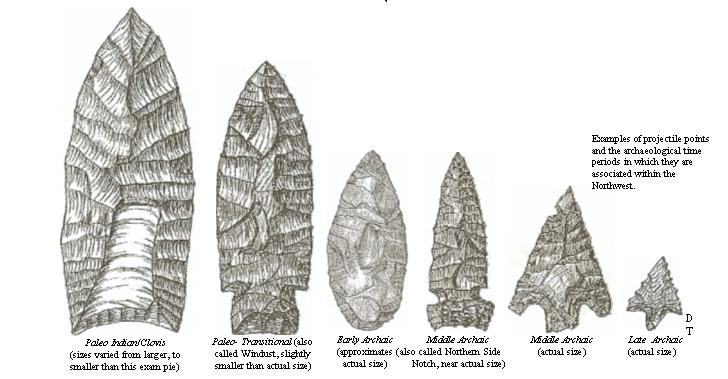
Flintknapping and stone tools - Flintknapping was a process whereby Stone Age people around the world as well as American Indi ans made flaked stone tools and weapons from specific types of stone. However, not just any rock could be transformed into a stone tool. Certain types of rocks had qualities ideal for knapping into tools. Flint refers to the stone used and knapping means to break or chip. A knapper is one who knaps stone or flint into tools. Examples of stone tools include: arrow points, drills, gravers, spear points, knife blades, scrapers, and atlatl dart points (Figure 1.) An atlatl throwing stick was used to throw a small spear or dart. It added an arms length extension to the hand of the thrower, greatly increasing the hunter's throwing power and range over the simple spear (Figure 2.)
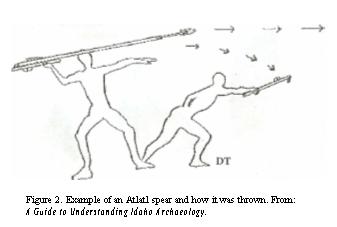
Early humans discovered that striking one rock against the edge of another (percussion flaking) could produce a very sharp edge (Figure 3.) With further refinements, they could produce instru ments for cutting, chopping, hunting, processing game, scraping hides and other needs.

How points and blades were made - In the Northwest, the raw materials used for these tools included: obsidian, chert, agate, jasper and calcedony. These rocks, often referred to as toolstones, have the common characteristic of conchoidal fracture, meaning that they break in a manner similar to glass. The classic example would be a window shot with a BB, leaving a near perfect cone-shaped hole in the glass. Conchoidal means shell-like. Fractured flaked stone surfaces are curved, rounded like a clam shell.
Percussion flaking involves hitting a harder core stone, such as obsidian, with a softer hammer (ex., sandstone, or deer antler), that then produces both a sharp flake and a sharp edge on the core stone where the flake broke off. The flakes could be discarded (commonly referred to as debitage), or used as scrapers for cutting and sawing. By continuing to strike along the edge of the core stone, a series of flakes would splinter off creating a long scalloped, but sharp, single-edged core tool. This process is now referred to as percussion flaking (Figure 3.), and results in the reduction of a stone into a core or a core tool.
Biface reduction occurs when a piece of stone is flaked on two opposing sides or faces, creating a
double-edged tool flaked on both surfaces (see Figure 4.)
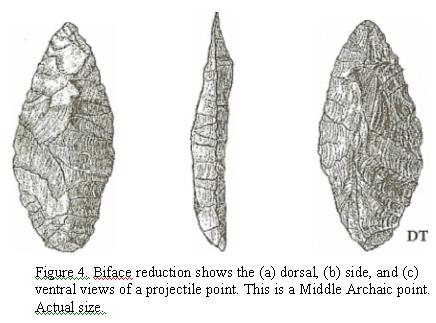
Pressure flaking is a process using controlled pressure on smaller areas along the edge of a core tool or biface, which results in a sharper, more refined edge (Figure 5.) Thus, pressure flaking is the shaping, finishing, or detail work, accomplished by using the point of a sharpened antler tine, antler segment, shaped bone, or even nails and other metal tools that may have been acquired in trade. Pressure flaking allowed the craftsman to sharpen and detail the point, edge, or base and to reshape it if the point was damaged in use.
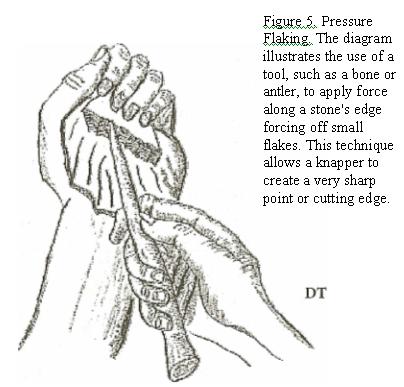
Projectile Points - The most common example of flintknapped stone tools is projectile points. Close examina tion of points found in archaeological excavations indicate that their shape and size over the last 12,000 years has changed. These changes show trends of the types of game available at certain times in prehistory. When archaeologists find these~ different types of projectile points they may be able to establish a relative date for an archaeological site on the basis of the type of projectile points found there.
Figure 6 identifies the different bases starting with Clovis, about 12,000 years ago, and ending with the very small Late Archaic points from 200 years ago. Comparisons reveal much about the age of the projectile point and the animals hunted.
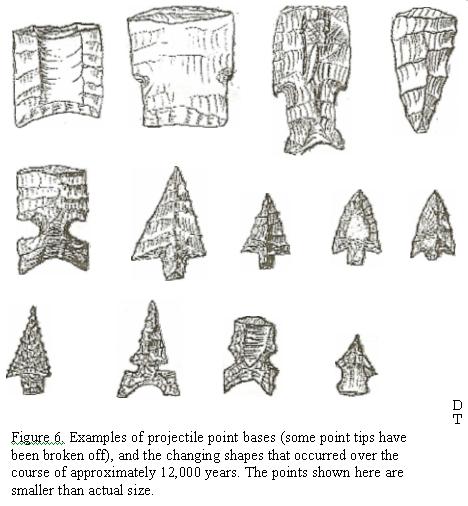
How the age of stone tools is determined - With one exception, stone tools cannot be dated by analyzing the chemical makeup of the stone it self. Organic materials contained in an archaeolog ical site, however, can be dated by the Carbon-14 process. The stone artifacts are then dated by asso ciation with the organic artifacts such as charcoal, basket fragments, plant materials, or bones. This is called relative dating.
The one exception is obsidian, which in some circumstances the flaked tool can be age-dated by hydration rind (or rim) measurement. This process measures how deeply into the flaked surface mois ture has penetrated. The hydration depth is used to determine the time elapsed since the tool was last flaked.
Another test called X-ray fluorescence can determine the specific obsidian flow that an obsidian artifact came from, thus sourcing the artifact. This information can provide clues about prehistoric trade and migration routes, and the test does not damage the artifact.
In the following discussion the dates and ages used are presented as' "BP': or Before Present. "Pre sent': however, always means the year 1950, when the Carbon -14 process was first used to date or ganic materials. A fixed reference date was needed, or "present" would continue to change yearly.
Time Periods and Stone Tools - Thus far, research indicates that the oldest pro jectile points and stone tools found in Oregon and Washington date back more than 12,000 years BP. These tools are described here according to the cultural period in which they were found. Cultural time periods are given relative dates based on spe cific geologic or other events (volcanic eruptions, human settlements, etc.) that define a certain period of time.
The following examples illustrate how people liv ing in this region between 200 and 12,000 years ago altered their tools in response to the changing environment in order to meet their needs.
A review of projectile points and stone tools in dicates there was a slow change in the flintknapping and lithic technology of humans in the west from 12,000 years ago to the present. This change shows a shift in weaponry from large tools such as throwing and/or thrusting spears and atlatl darts, to the smaller bow and arrow.
Thrusting spears and possibly atlatls from 10,000 to 12,000 years BP were used on large Ice Age mega fauna, such as mammoths. These large ani mals could only be successfully hunted with large, sharp, and sturdy weapons. Postglacial animals, by comparison, were not as large. Spears were used less and atlatls were used more in the hunt for these animals, so the projec tile points correspondingly decreased in size.
The bow and arrow came into use about 2,000 years ago which resulted in another reduction in the size of projectile points. By the time of the Late Archaic phase (between 230 and 2,000 years BP) most projectile points were not much over 1.5 cm (5/8 inch) wide but could still be used for deer and elk because of the high efficiency of the bow. See Figure 22 on page 10 for a comparison of pro jectile points.
The following periods illustrate the changes in projectile points and stone tools in general over the last 12,000 years of human history in Oregon and Washington.
Paleo Indian/Goris Period - The Clovis, or Paleo Indian Period, occurred be tween 12,000 to 10,800 years BP.
Clovis artifacts have been found in all 48 lower states and is the first culture to leave clear indica tions of occupation in Oregon. The name Clovis comes from a site where these unusual points were first discovered near Clovis, New Mexico (Figure 7.)
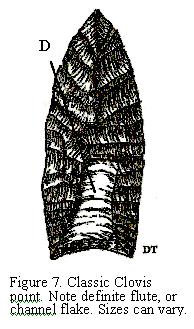
The Clovis point was attached to a foreshaft, which was inserted into a long handle or spear. They were made by percussion flaking a large pre form to the desired size and general shape. The biface was then pressure flaked to prepare the base for fluting.
Clovis points are characterized by a flute, or a large channel flake that was struck out of the blade from the base, directed toward the tip - usually on both sides. flute Fluting allowed the stem of the spearhead to be firmly affixed, or hafted to the fore shaft of a spear (Figure 8.)
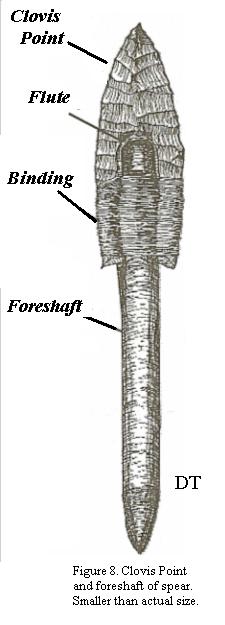
Evidence shows that these spearheads were used more than once and sharpened and resharpened until they were no longer serviceable. Clovis points range in length from 3 to 25 cm. (1 to 10 inches.) Research indicates that hey were used and resharpened many times.
Clovis points had to be large, strong and sharp be cause the game that hunters were targeting during the last flute ice age included large mammals such as, mastodons, mammoths, bison, ground sloths, and possibly camels.
Twelve individual Clovis points have been found in western Oregon. Two, named Fern Ridge and Cottage Grove Clovis, were discovered in the Eugene and Cottage Grove areas, respectively.
The Fern Ridge Clovis point is made for a caramel to red-brown colored chert. It measuers 8.29 cm long by 3.19 cm wide (roughly 1 /4 inches long by 1 1/4 inches wide). and about 8.2mm thick (3/8 inch). It weight 25.85 grams and is fluted on both sides; with one flute longer that the ofther (Figure 9)
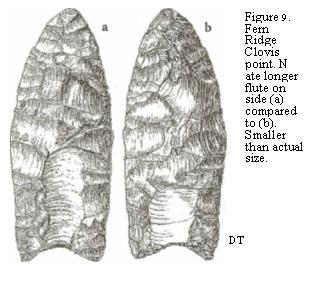
The Cottage Grove Clovis point is made of a gray banded obsidian. This particular point measures l3cm long by 4.12 cm wide and .97 cm thick. It shows little evidence of use or reworking and may have been abandoned early in its life. Scratches and abrasions are missing from the channel scars. X-ray fluorescence indicates the source of its obsidi an was Glass Buttes in central Oregon.
Originally, this point was thought to be a Folsom' point because the fluting extended from the base to the tip (a major characteristic of Folsom points which have not yet been found in Oregon.) After further analysis, researchers determined that, despite the unusual fluting, other characteristics (ex curvate margins, narrow flute channel scar, and the percussion edge finishing) placed it firmly within the Clovis technology (Figure 10).
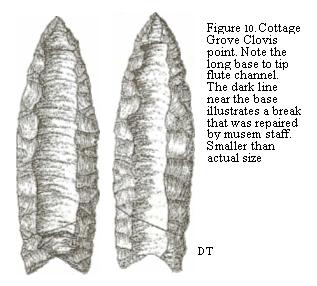
Despite the 12 documented Clovis points from western Oregon, researchers have found little evidence of campsites, quarries or reduction (manu facturing) sites. . However, such sites have been found in eastern Oregon. The tool stones of western Oregon Clovis finds include chert, jasper and obsidian. In several in stances the raw materials of the Clovis tools are similar to raw materials available in the immediate area.
The geographic proximity of the Clovis finds and the location of the tool stone sources appears to indicate that at least some of the points were made, used and discarded within a small local area. But on the other hand, all 4 of the obsidian Clovis points from western Oregon are examples of long- range travel and transportation of tool stones.
The Cottage Grove tool stone, for example, was transported over 200 miles westward from Glass Buttes in southeastern Oregon to where it was found. Either way, the people who made these points were familiar with the raw material resources in the region and pursued a livelihood there at least for awhile.
The discovery of the dozen Clovis points or fragments in various contexts in western Oregon suggests a widespread, if faint, presence of late Pleis tocene Clovis culture in this region. The fact that the points generally occur as surface finds with few or no other associated artifacts has provided an in teresting problem: How to explain the presence of Clovis artifacts without the presence of Clovis oc cupational sites. A question for future archaeolo gists to answer.
Paleo-transitional/Initial Archaic Period - The Paleo-transitional or Initial Archaic Period is identified as occurring between 10,500 and 8,000 years BP. Projectile points of this period found in Oregon and Washington are often referred to as Windust points.
Between 1959 and 1961, archaeologists found an undisturbed cultural sequence in one of several caves along the Snake River in southeast Washing ton known as the Windust Caves. This cultural pe riod represents people whose artifacts appear after the Clovis culture. The Northwest climate at this time was no longer an ice age, but definitely cooler and wetter than it is now. Researchers refer to it as the anathermal climactic phase.
From archaeological evidence, the Windust culture remained fairly stable for at least 2,500 years. Their tools reflect adaptations to the dis appearance of large ice age mammals.
The fluted Clovis point was displaced by leaf shaped and stemmed points, now referred to as Windust points (Figure 11.) These points were approximately 12 cm (5 inches) long, 3 cm (1.5 inches) at their widest point, and 2.5 cm (1 Inch) Wide at the stemmed base.

The Windust people were nomadic and lived in rock shelters and open sites throughout eastern Washington and Oregon. Their main prey was deer, elk, bison, birds and small mammals. Archaeological sites along the Columbia River indicate that about 8,500 years BP, the Windust people also incorporated salmon fishing into their food gathering.
A sample Windust tool kit may have included: flaked projectile points, knives, scrapers, choppers and drills, eyed needles of bone or antler, awls, fleshing tools, barbed points, beads, wedges, atlatl, and flintknapping tools for percussion and pres sure flaking.
Early Archaic Period - The Early Archaic sequence is known for the Cascade Point type, and sometimes called the Cas cade Phase which lasted from 8,000 to 6,500 years BP. A Cascade point is a bi- pointed or willow leaf-shaped point that ranges in size from about 2 to 7 cm (1 to 3 inch es) long. Both percussion flak ing and pressure flaking were used in their manufacture (figure 12).
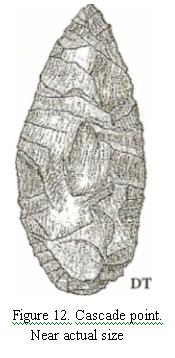
Although hunting and fish ing were the primary means of getting food during this phase, there was also an increased use of plant foods such as berries, seeds, roots and tubers. Evidence for this is found in the occurrence of edge ground cobbles and other ground stone tools (Fig. 13). These were used to grind or pulverize plant material and possibly dried meat and fish. This technology added yet another array of stone tools - ground stones - to the archaeological record.
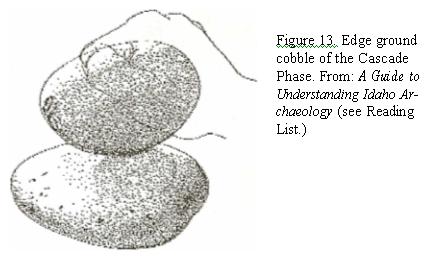
During this part of the Early Archaic, the cli mate was still cooler and wetter than now, but beginning to change to a warmer, drier climate. The end of this period, and the Cascade Culture, is generally accepted to coincide with the eruption of Mt Mazama, resulting in the formation of what is now known as Crater Lake.
Middle/Archaic Period - The Middle Archaic is divided into two parts. The first part of the Middle Archaic (6,500 - 3,500 years BP) began after the eruption of Mt. Mazama and lasted for the next 3,000 years. Compared to the previous six thousand years, during this period the climate became hotter and drier than ever before or since.
Artifacts of the Middle Archaic are marked by the appearance of long side-notched points with several variations, most notably, the Cold Springs point, the Northern Side Notch and the Elko points. These points were smaller than the Clovis and Win dust points, reflecting the smaller post Pleistocene game being hunted, but could be more easily attached to the short darts (about 4 feet long) that were used with the atlatl (Figure 14.) The Northern Side Notch and Elko points were made from pressure flaked biface preforms reduced to the desirable shape and thinness and then pressure flaked to the preferred shape. They range in length 5-15 cm (2-6 inches).
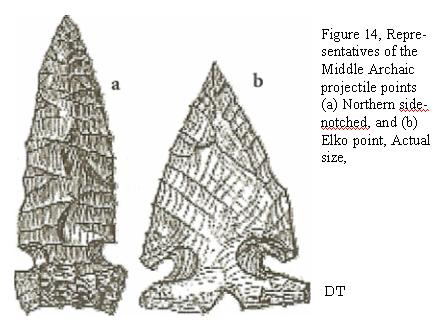
Surprisingly, the bow and arrow had not yet appeared in North America, although long distance trading appears to have begun about this time.
A sample Middle Archaic tool kit probably included percusion and pressure flaking tools,atlatl darts and several foreshafts with Northern Side Notch or Elko points attached for hunting. The kit may have also included fishing tools such as net sinkers, nets, gorges, hooks, harpoon points and spears.
An improved mortar and pestle system, the hop per mortar, for grinding food replaced the edge -ground cobbles of the Cascade culture (Figure 15.) Pit house village s with rock-lined fire pit ovens also began to appear during this phase.
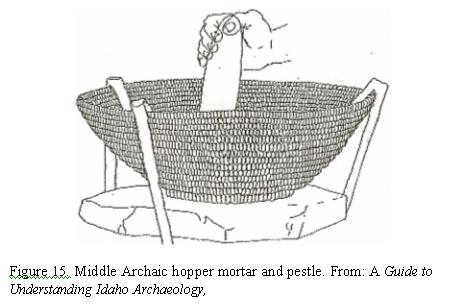
The second part of the Middle Archaic Period occurs between 3,500 and 2,000 years BP. The projectile points found during this time include a va riety of large corner-notched and stemmed points that were used specifically for atlatl darts. They were approximately 4 cm (1.5 inches) long.
Hunting with the spear and/or the atlatl contin ued through this period (Figure 16.) Dalles area of Oregon was a "hub" of trading dur ing this phase. Artifacts found throughout this area include stone and bone tools, as well as portable and stationary art. Rocks such as galena and slate from west of the cascades were traded east, and nephrite from British Columbia made its way south in the form of adze, or axe-like, ground stone blades.
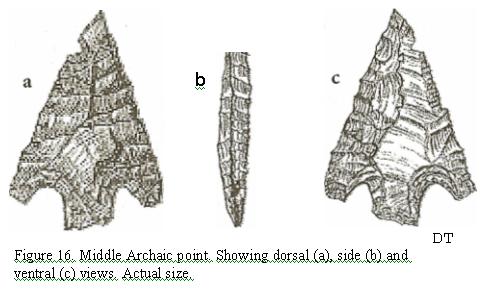
This phase also saw a shift from a nomadic lifestyle to the establishment of villages, usually near waterways or lakes. Archaeological evidence of clusters of pit houses throughout the Northwest indicates this type of habitation was the norm for this phase. In addition, the eating habits changed to include a greater dependence on salmon, shell fish, roots and berries.
Late Archaic Period - This period spans prehistory from 230 to 2,000 years BP. About 2,000 years ago the bow and arrow appeared in the Great Basin, the Northern Plateau and the Northwest coastal geographic and cultural areas.
With the introduction of the bow and arrow, there was also a corresponding decrease in the size of projectile points. The projectile points of this phase have several types of bases, including stemmed, unstemmed, side notched and corner basal notch. They ranged in size from 1-5 cm (1/2 to 2 inches) in length. Compared to the atlatl darts, these points were much smaller, as the lighter ar row could be projected from the bow at a much greater speed and distance.
The epitome of the flaked points' beauty is represented by the many "Columbia River Gem Points" that were recovered from sites before many of the dams were built. These small and delicate points were almost all done entirely by pressure flaking (Figure 17.)
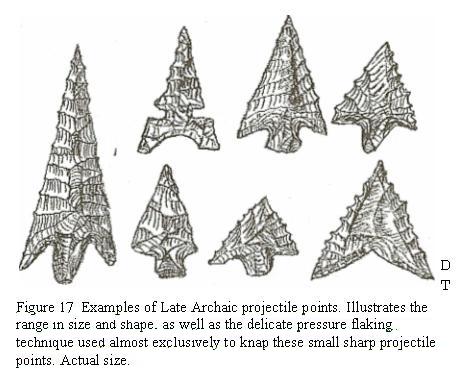
There are more archaeological sites of the Late Archaic period than of any of the previously de scribed periods. These sites include: pit house villages, open camp sites, rock shelters, large year -round villages, smaller winter villages and seasonal campsites.
Artifacts of this phase include tools for hunting, fishing, gathering and processing plants. There were also tools for working wood, bone and stone for decorative objects. The end of this phase is de noted as the early 1700s when the horse and Old World trade goods were introduced to the native tribes.
Proto-Historic Period - The Late Archaic period and its native cultures came to an end in the late 1600s, when the Proto Historic Period began. This last and most recent period began with the appearance of Old World trade goods. It represents the introduction of the horse, and regular contact between the tribes and traders, trappers, and settlers. These were the native cultures of the Northwest that the early explorers observed. The date of the introduction of the horse varies, occurring first in southern Idaho around 1690 and taking another 40 years to reach Oregon and eastern Washington.
Once European-American contact occurred, projectile points changed. Now they were not only made of stone, but also of glass or metal, with met al having some distinct advantages. Projectile points were made from metal scavenged and trad ed with the settlers and averaged about 5 cm (2 inches) in length (Figure 18.)
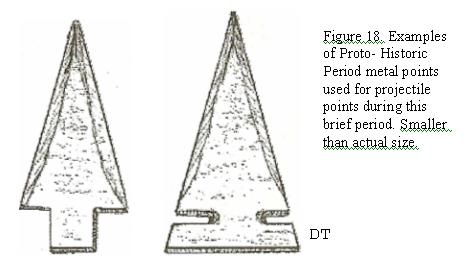
Metal barrel straps could be easily cut into small triangles and used as points. Metal points could be shaped and sharpened using abrasive honing stones such as sandstone or even basalt, which could be procured from local gravel deposits or geological formations.
Once files became available, metal points could be shaped and sharpened to represent a culture's traditional point type. Pressure flaking tools for flintknapping continued to include bone and antler, but could also include nails or iron rods mounted onto a wooden handle.
With the passing of time many of the traditional tool making skills diminished as the spread of the settlers also brought new technology. By the early 20th century American Indians had incorporated the new tools and materials (guns, knives, cooking utensils, rope, and fabric) into their everyday lives. Thereafter the flintknapping skills were no longer being taught within the tribes and the techniques almost disappeared from the native landscape.
Ishi: A Stone Man in the Modern World - A man from a tribe of northern California Indi ans walked scared and starving out of the wilderness and into the modern American landscape in August of 1911. Initially unable to communicate, he was believed to be the last surviving member of the Yana Indian tribe. He was given the name Ishi, meaning "Man" in the Yana language, and de scribed in the press as the last Stone Age man in North America.
Ishi was not completely stone age however, be cause he was compelled by isolation and hostilities with ranchers of that time to use metal nail flaking tools, and broken bottle glass that he foraged from along the Lassen Trail (near Mt. Lassen) for his projectile points (Figure 19.)
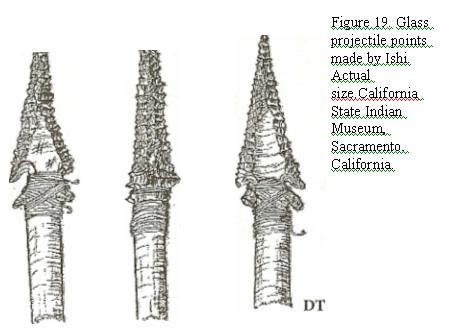
From 1911 to 1916, Ishi lived at the Museum of Anthropology at the University of California, San Francisco, giving knowledge and insights of his "peoples" ways to anthropologists Alfred 1. Kroeber and Thomas Talbot Waterman and his physi cian Dr. Saxton Pope. . He died in early 1916 from tuberculosis. Although given the name Ishi by Kroeber, his real name was never known because in his tribal belief system it was not appropriate to give out his name to anyone other than members of his tribe. Later, in the 1990s his tribal affiliation would also come under some dispute.
During his time with Kroeber and Waterman, Ishi provided extraordinary insight into the tool making of his era. Examples of his projectile points and other tools are part of the University's collections and can be viewed both in books and online (Figures 20 and 21.)
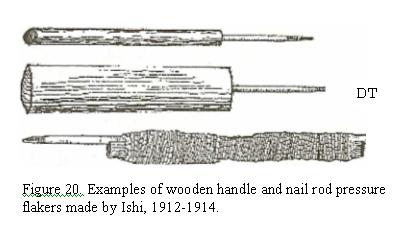
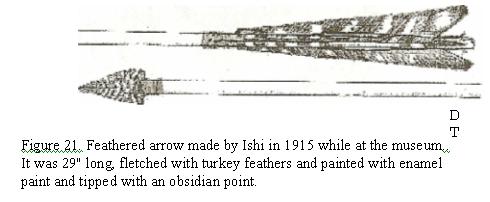
Ishi's brief time in the American spotlight is both a deeply compelling human interest story and a revealing look at a sole-surviving member of a group of American Indians who relied on stone tools well into the 20th century in North America (see the Reading List and Websites List on pages 11-13, for more information.)
Comparing Projectile points - The projectile points illustrated below represent the variety of shapes and sizes that occurred over the last 12,000 years based on materials recovered at archaeo logical sites within Oregon and parts of Washington.
The variety in shape and size reflects the changes in the type of animals hunted and represents the types of points developed by the American Indian people to meet their needs using materials available to them. Those from the Proto-Historic period are not included below.
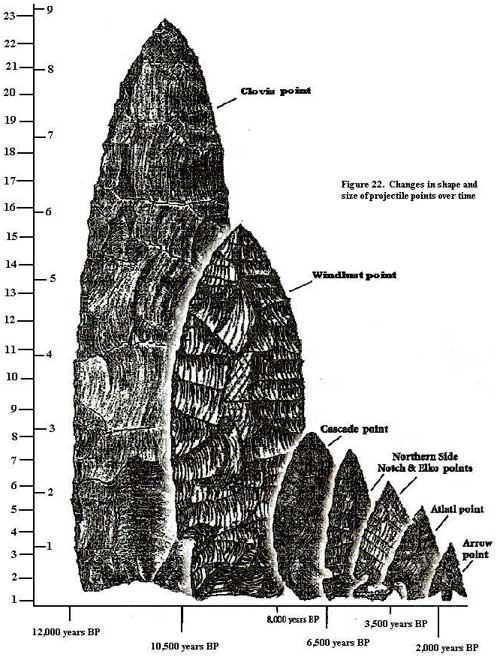
FLlNTKNAPPING READING LIST - The materials listed below include some of the references used for this document as well as other books educators may find useful when developing lesson plans on flint knapping. Those books denoted with an asterisk (*) provided information used this publication.
All of these books should be readily available through most book stores and libraries. All of these resources are at an adult reading level unless otherwise indicated.
Books
* A Guide to Understanding Idaho Archaeology, by B. Robert Butler, Curator of Archaeology, Idaho State University Museum, Pocatello, Idaho, 1966.
American Flint Knappers: Stone Age Art in the Age of Computers, by John C. Whittaker. Published by the University of Texas Press, July 2004.
Ancient Encounters: Kennewick Man and the First Americans, by James C. Chatters, Touchstone, 2001. An Introduction to Flint Working, 2nd Edition, by Don E. Crabtree. Occasional Papers of the Idaho Museum of Natural History, Number 28.
* Archaeology of Oregon, by C. Melvin Aikens. Published by Bureau of Land Management, Oregon State Office, US Department of the Interior, 1986, 1993.
Early Hunting Tools: An Introduction to Flint Knapping, by Matt Gravelle. Published by Pine Orchard, January 200l.
*Exploring Washington Archaeology, by Kirk and Daugherty. University of Washington Press, Seattle. 1978, 1981.
Flint Knapping, by Paul Hellweg. Published by Canyon Publishing Co., June 1984.
Flint Knapping Flash Cards: Pressure Flaking of Flakes. (Dr. Callahan's 20 card answer to how to make an arrow point from a flake by pressure. A picture on one side, a description the other.) Piltdown Productions.
Flint Knapping: Making and Understanding Stone Tools, by John C. Whittaker. Published by University of Texas Press, May 1994.
*Handbook of North American Indians, Volume 17, Northwest Coast, Wayne Suttles, Editor. Smithso nian Institution, Washington, DC. 1990.
*Handbook of North American Indians, Volume 11, Great Basin, W. Sturtevant, Editor. Smithsonian Institution, Washington, DC. 1986.
*Indian Rock Art of the Columbia Plateau, by James D. Keyser. University of Washington Press, 1992. Lithic Debitage: Context, Form and Meaning, by William Andrefsky. Published by University of Utah Press, June 200 l.
Lithics, by William Andrefsky. Published by Cambridge University Press, November 1998.
Making Silent Stones Speak: Human Evolution and the Dawn of Technology, by Kathy D. Schick and Nicholas Toth. Published by Simon and Schuster, 1993.
Old Tools - New Eyes: A Primal Primer on Flint Knapping, by Bob Patten and Richard Jagoda (illustra tor). Published by Stone Dagger Publications, February, 1999.
*Peoples of the Northwest Coast: Their Archaeology and Prehistory, by Kenneth Ames. Thames and Hudson, London, 1999.
*Stone, Bone, Antler & Shell: Artifacts of the Northwest Coast, by Hilary Stewart. University of Wash ington Press, 1996.
*The Basics of Biface Knapping in the Eastern Fluted Point Tradition, by Errett Callahan, Ph.D. Reprinted from Archaeology of Eastern North America, 7, 1979, by Pi It down Productions, 1996.
Articles
"'Obsidian Clovis Points in Western Oregon, by Terry Ozbun and Dan Stueber, Archaeological Investiga tions Northwest, Inc.
*The Circumstantial Evidence for Clovis Occupation of Western Oregon, by Terry Ozbun, Eric Forgeng and Dan Stueber, Archaeological Investigations Northwest, Inc. Presented at the Fall meeting of the Associa tion of Oregon Archaeologists, November 8, 1997, US Hotel, Jacksonville, Oregon.
|
